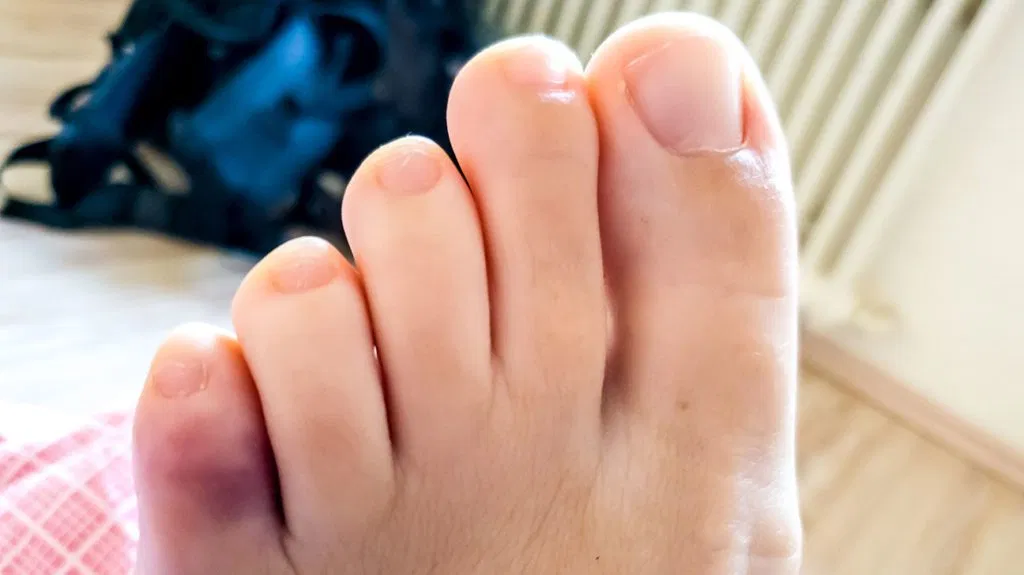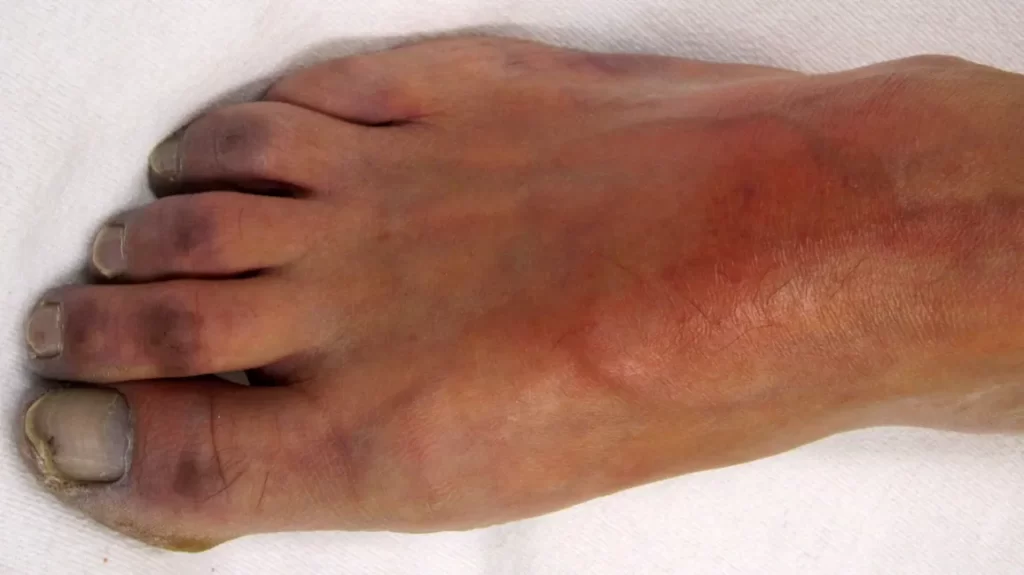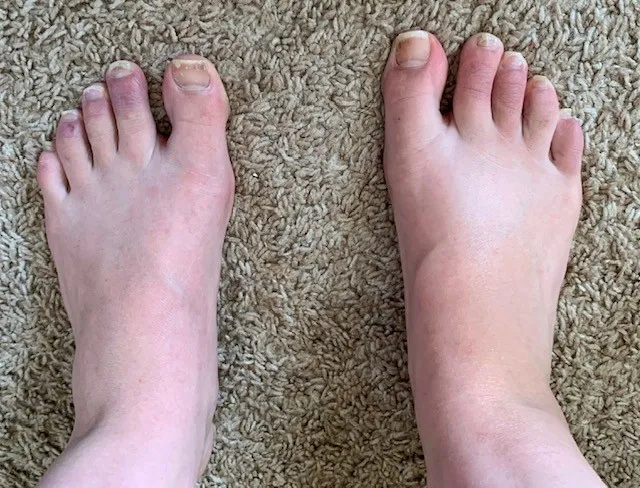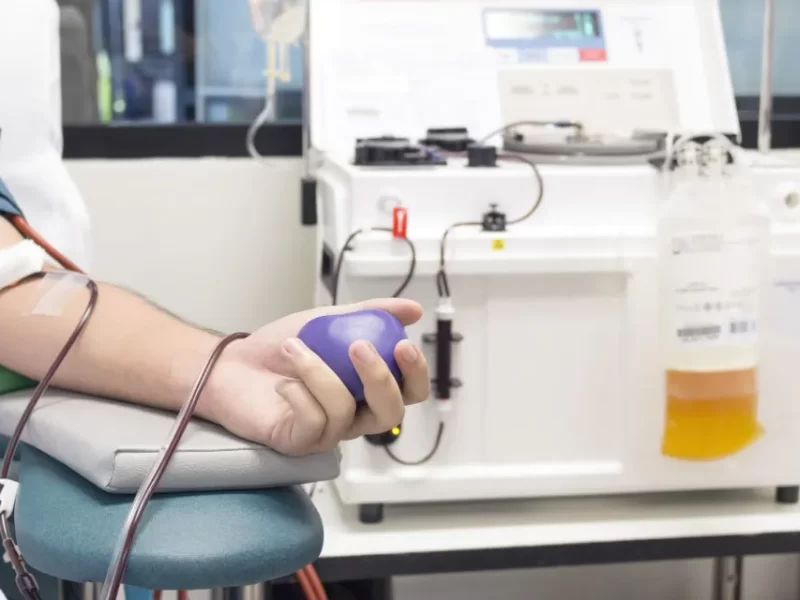Feet that are purple or blue could indicate a medical condition. Foot discoloration may be brought on by trauma, Raynaud’s syndrome, peripheral arterial disease, or frostbite.
Bruising can cause the skin to turn blue or purple, but this color change can also mean that not enough oxygen-rich blood is getting to the area. Due to their distance from the heart, the feet are especially vulnerable to discoloration. You need to pay attention if one of your toes has unexpectedly changed to this dark, vivid shade! Toes can turn purple for a variety of reasons.
Why Are My Toes Purple?
Foot Injuries
Bruising, which typically turns the skin blue or purple, can be brought on by sprains, strains, or dropping something on the foot. Along with pain and swelling, such an injury frequently results in both. People can usually treat minor foot injuries at home using RICE therapy:
- Rest. Avert engaging in pointless activities and putting undue pressure on the injured foot.
- Ice. Apply an ice pack to the hurt foot.
- Compression. Bandage the hurt foot. The bandage should be snug but not so tight that it restricts blood flow.
- Elevation. Whenever possible, raise the foot by using pillows or a footstool.
Pain and swelling can be diminished with the aid of over-the-counter nonsteroidal anti-inflammatory drugs like aspirin or ibuprofen.
To check for broken bones in the foot after more serious injuries, a doctor may prescribe an X-ray. The type and seriousness of the fracture determine the course of treatment for a broken foot.
Raynaud’s Disease
A common condition called Raynaud’s disease also referred to as Raynaud’s phenomenon can temporarily constrict and spasm the blood vessels in the hands and feet. Blood flow is obstructed as a result of this behavior, which can cause the affected areas to turn blue, purple, red, or white.
Pins and needles, numbness, and pain are additional symptoms of Raynaud’s disease attacks. A person may find it difficult to move their feet or fingers as a result of these attacks.
Raynaud’s syndrome can be brought on by stress, anxiety, and cold temperatures. Attacks are frequently transient and end once a person warms up or the stress level decreases.
Most of Raynaud’s cases are mild. Preventing attacks can be accomplished by ensuring that the hands and feet are warm and dry during cold weather and by reducing stress. A doctor might recommend medication to help control symptoms in people with more severe cases of Raynaud’s.
Additionally, lupus or rheumatoid arthritis may show symptoms of Raynaud’s disease. To rule out other conditions, anyone exhibiting Raynaud’s disease symptoms should visit a doctor.
Lupus
Systemic lupus erythematosus, also known as lupus, is an autoimmune disease, meaning that healthy tissues and organs are mistakenly attacked by the body’s immune system. Lupus symptoms can affect many different parts of the body, including the feet, and range greatly in type and severity.
Extreme fatigue, swelling, and pain in the joints are typical lupus symptoms. The Lupus Foundation of America estimates that up to one-third of lupus patients also have Raynaud’s disease.
Inflammation of the blood vessels, or vasculitis, can result from lupus. Vasculitis can result in a rash on the feet that looks like red or purple dots on the skin. Other parts of the body may also develop this rash. Additionally, numbness, tingling, and loss of strength in the foot may be brought on by vasculitis.

Anyone exhibiting lupus symptoms ought to visit a physician. Depending on the symptoms, lupus is treated. Compared to lupus, which affects various body parts, mild vasculitis, which only affects a person’s skin, typically requires less intensive treatment.
Ischemic Foot
Ischemia describes a decrease in the healthy blood flow through one or more arteries. If your foot is ischemic, it’s because not enough oxygen-rich blood is reaching it.
One of the major arteries supplying blood to your foot can become clogged with cholesterol plaque, causing ischemic foot. A blood clot in an artery that is obstructing blood flow is another possibility. From blunt trauma or puncture wounds, an artery can occasionally suffer harm. Risk factors for ischemic foot include:
- high cholesterol
- high blood pressure
- diabetes
- having a history of vascular problems
- obesity
You might experience pain in your feet and lower legs when you walk in addition to your toes and feet turning purple. In severe cases, you might even experience pain while you’re lying down.
Maintaining healthy levels of cholesterol, blood pressure, and blood sugar are essential to preventing ischemic foot. Along with regular exercise, a healthy diet, and prescription medications, this may be necessary. Additionally, you ought to stop smoking because it can seriously damage your blood vessels.
Peripheral Artery Disease
The arteries outside of the body’s core narrow due to peripheral artery disease (PAD). Some of the body’s external regions, including the limbs, have their blood flow restricted.
Pain, cramping, tingling, and weakness are among the symptoms of PAD, which frequently affects the legs. Less blood flow can also gradually turn the legs and feet blue or purple. However, some PAD sufferers might not show any symptoms.
Anyone exhibiting PAD symptoms ought to visit a physician. If the condition is not treated, it may worsen and cause life-threatening complications like severe ischemia and gangrene.
An entire leg or foot may need to be amputated in extreme circumstances. The risk of heart disease, heart attacks, and stroke is also increased by PAD.
The condition’s progression can be slowed or stopped, and the risk of complications can be decreased through dietary adjustments, medication, and surgical procedures. Regular exercise, quitting smoking, and a healthy diet are all positive lifestyle choices.
Acrocyanosis
Additionally, acrocyanosis lessens the healthy blood flow in the arteries in your feet. The term “acrocyanosis” refers to a bluish discoloration of the skin brought on by decreased oxygenation to the extremity.
Usually, it is brought on by tiny blood vessels close to the skin’s surface spasming. An artery spasms when it suddenly constricts. The blood flow in your artery may be severely reduced or even stopped by this momentary tightening.
Your hands may experience acrocyanosis, which results in blue or purple skin on them. There are usually no other obvious symptoms associated with this painless condition. The condition also usually affects women more often than men.
Acrocyanosis can be brought on by both emotional stress and the cold. Keeping your hands and feet out of the freezer may help you avoid future episodes.

Diabetes
Diabetes can have a negative impact on your feet in two significant ways: by reducing healthy circulation and by reducing healthy nerve function. Your toes and feet may appear discolored if diabetes is affecting your circulation. Your feet’s skin could turn blue, purple, or gray. Additionally, you might get a rash or red or purple skin patches.
Diabetes causes circulation issues because high blood sugar levels can harm the lining of your arteries. This may eventually lessen normal circulation, particularly to your lower legs and feet. You might experience bruising or cuts that don’t heal properly, as well as swelling in your ankles and lower legs.
The complications of diabetes can be avoided by maintaining a healthy blood sugar level. That typically means aiming for a fasting blood sugar reading of fewer than 100 milligrams per deciliter.
Frostbite
Because your body prioritizes healthy circulation to your internal organs over normal blood flow to the extremities, cold temperatures can reduce circulation in your hands and feet. The circulation in your fingers and toes may return to normal simply by moving from the chilly outdoors to the warm interiors or by putting on some gloves or socks.
The risks are much greater when it is extremely cold outside. Skin exposed to extremely cold temperatures can become frostbitten. Your face, hands, feet, and other body parts are typically the most vulnerable. The exposed skin becomes red and hard from superficial frostbite. However, severe frostbite can cause purple skin. The skin may continue to be purple even after it has warmed up. A medical emergency has occurred here.
Avoiding exposure to extremely low temperatures is the best defense against frostbite. Ensure that you are dressed in clothing that shields the entire body from the cold.
Treating and preventing purple feet
Medications or procedures that maintain healthy circulation are frequently used as treatments for these conditions. Simple preventative measures and living a healthy lifestyle can sometimes be sufficient.
Amputation might be required if the circulation damage to your foot is severe enough to pose a risk of foot tissue death. However, medical professionals should only use that as a last resort after all other options have failed.
Before such a drastic step is taken, the following treatments may be appropriate:
Treating Ischemic Foot
You may also need to take aspirin or other antiplatelet medications in addition to maintaining proper blood pressure, cholesterol, blood sugar, and smoking cessation levels. In severe cases, surgery may be necessary to connect a blood vessel from another part of your body to the affected artery, providing a path for blood to bypass the constricted area of the artery.
Treating Acrocyanosis

Calcium channel blockers might be suggested by your physician. These drugs support healthy blood flow by keeping your arteries open and lowering blood pressure inside your arteries. Minoxidil and derivatives of nicotinic acid applied topically may also ease symptoms.
Treating Raynaud’s Disease
In cold weather, wearing gloves and thick socks may help prevent episodes. It may also be necessary to take medications like calcium channel blockers or vasodilators, which help keep smaller arteries open. Usually, less invasive treatments are sufficient. In severe cases, nerve surgery that involves the removal of tiny nerves from around blood vessels in your affected hands or feet may help lessen the response to cold temperatures.
Treating Diabetes
To help maintain a healthy range of your blood sugar levels, your doctor may prescribe drugs like metformin. If you have type 1 diabetes, you might also require frequent insulin injections.
Treating Frostbite
First-degree frostbite and other cold-weather injuries can be treated by soaking the affected skin in a warm bath for 30 minutes to an hour, then allowing it to air dry. Do not rub ice-burned skin. Give it careful attention and have a doctor examine it. If any tissue has been irreparably harmed, surgery might be required to remove it. Toes may be included in this.
The Takeaway
Purple feet could have a variety of underlying causes. Bruising after a minor injury can lead to skin discoloration. But purple or blue skin can also be a sign of a restriction in blood flow to the feet, which may be a sign of a more serious medical issue.
Obtain routine blood tests and physicals. By doing this, you and your doctor will be able to recognize early indications of conditions like high cholesterol, diabetes, or other conditions that may affect the color and future of your feet.



